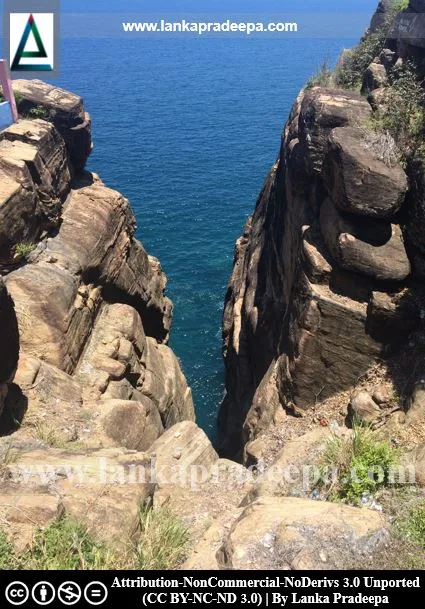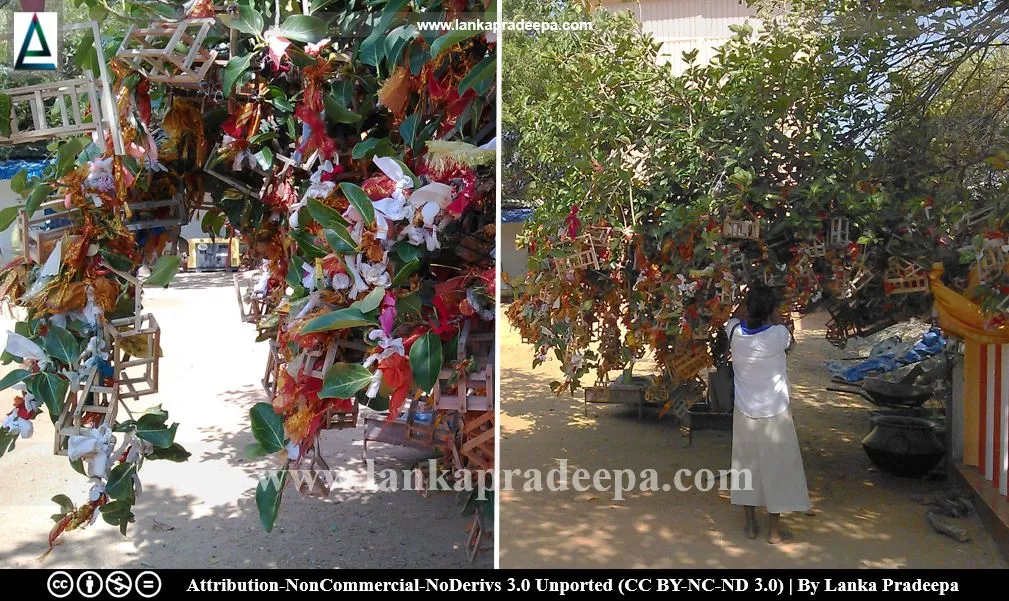
Koneswaram Temple, also known as Thirukkoneswaram Kovil (Tamil: திருகோணமலை கோணேச்சரம் கோயில்; Sinhala: ත්රිකුණාමලය කෝනේෂ්වරම් කෝවිල), is a famous Hindu Kovil/temple in Trincomalee, Sri Lanka. The temple has been built on the top of a rock situated on the brink of the sea and can be reached through the main entrance of Fort Fredrick. Koneswaram is traditionally considered one of the ancient Saiva shrines in the country.
History
The origin of the Koneswaram temple is obscure (Dharmadasa, 1976; Gunasingam, 1975). However, its history can be composed with the help of the nearby Trincomalee Harbour, one of the ancient seaports in the country. Trincomalee was a well-known harbour in the region and Koneswaram may have been built on this seaport to fulfil the religious needs of the Hindus of the area as well as the merchants who landed at the port. The Indian Hindu text Vayu Purana (this ancient work is generally assigned to the first half of the 1st millennium A.D.) mentions about a temple of Siva named Gokarneswaram located on the eastern coast of an island (Gunasingam, 1975).
"30. In that island, on the eastern shore of the sea there is Gokarna, the great shrine of Sankara."Reference: Tagare, 1987. p.311.
This Siva temple in Gokarna is believed by some as the present Koneswaram temple in Sri Lanka (Gunasingam, 1975). However, some scholars identify this locality named Gokarna as a place in West South India dedicated to Siva (Dharmadasa, 1976; De Silva, 2006; Ramachandra Dikshitar, 1951).
The Pali chronicle Mahawamsa (Chapter XXXVII: 40-41) records that King Mahasena (274-301 A.D.) built Gokanna Viharaya after destroying a Brahmanical temple at the site (De Silva, 2006; Gunasingam, 1975; Nicholas, 1963). Besides Gokanna, Mahasena founded two more Buddhist Viharas; one at Erakavilla, and the other at Brahman Kalnda (Geiger, 1912). According to Mahavamsa Tika, the Gokanna Viharaya was on the coast of the eastern sea while the other two were in the region of Rohana (Geiger, 1912). According to some, the Brahmanical temple destroyed by Mahasena is the present Koneswaram temple (Gunasingam, 1975).
Daksina Kailasa Manmiam, a section of the Indian Sanskrit Skanda Purana (about 8th century A.D.) mentions that from very ancient times nine sacred shrines were famous for the Hindus. Among them, two were in Sri Lanka namely Koneswaram and Tiruketheeswaram (Navaratnam, 1998). However, the first credible reference to the Koneswaram temple is found in the 11th century A.D. South Indian Cola inscription that was discovered at a locality in Nilaveli near Trincomalee (De Silva, 2006).
Nilaveli inscription
A slab inscription known as the Nilaveli record was found within the premises of Pillayar temple in Nilaveli, a small town located 14 km northwest of Trincomalee town (Gunasingam, 1975). This record contains 14 lines of writing indited in an admixture of Grantha and Tamil characters and has been dated to the early 11 century A.D.; the beginning of the Cola rule in Sri Lanka (Gunasingam, 1975). According to Gunasingam, the palaeography of this inscription very closely resembles that of the periods of Rajaraja I (c. 985-1014 A.D.) and Rajendra I [(c. 1014-1044 A.D.) Gunasingam, 1975].
This inscription records a donation of two hundred and fifty Veli of irrigated and unirrigated lands to a temple named Maccakesvaram at Tirukonamalai (present Trincomalee) to meet its daily expenses (Gunasingam, 1975). The Maccakesvarama temple (Visnu ?), referred to in the inscription, is said to be the present Koneswaram temple (De Silva, 2006; Gunasingam, 1975).
Besides the Nilaweli inscription, another reference to the Koneswaram is found in the Manankeni inscription of Cola Illankesvaradeva, the representative of Sri Lanka of Cola King Rajendra I (Gunasingam, 1975).
Portuguese Period
The Koneswaram temple was looted in 1624 by the Portuguese and was completely demolished by Constantine de Sa to employ its materials for the building of the fort (Navaratnam, 1998; Sarma, 2007). Some of the statues in the temple were taken by locals to Thambalagamuwa where later a temple to the lord of Koneswaram (Ati Konanayakar Temple) was built by King Rajasinha II [(1635-1687 A.D.) Navaratnam, 1998].
Dutch and British occupation
During the Dutch occupation of Trincomalee, the site was not allowed for the public to perform their religious activities (Navaratnam, 1998). However, permission was given to them by the British when they displaced the Dutch in 1795 (Navaratnam, 1998).
Present temple
The present Koneswaram temple was constructed by the Hindus on 3 March 1963.
Ruins
In 1944, two images of Vishnu and Lakshmi were unearthed inside the fort area (Navaratnam, 1998). Several bronzes of deities such as Ganesha (standing) and Parvati (seated, standing), Siva (seated), and Chandrasegara were also discovered at the site, later (Navaratnam, 1998).
A fragmentary slab-inscription of the reign of Rajaraja I
Reign: King Rajaraja I (985-1014 A.D.)
Period: 10th-11th centuries A.D.
Script & Language: Medieval Tamil
This inscribed fragmentary slab was discovered in 1961, by underwater explorers who searched antiquities of the demolished temple at the bed of the nearby sea (Gunasingam, 1979). It is presently preserved on the premises of the Koneswaram Temple.
The remaining slab is about one foot long and six inches wide and contains 9 lines of writing (Gunasingam, 1979). A portion of the meykkirtti (prasasti) of King Rajaraja I (a South Indian king who reigned from 985 to 1014 A.D.) is found recorded on the slab (Gunasingam, 1979).


.
See also
Attribution
1) This image (Koneswaram inscription Pandyan era) has been released into the public domain by its creator, Dushipillai.
References
1) De Silva, D.G.B., 2006. A Study on Trincomalee in the 16th and 17th centuries with special reference to relations with Arakan as revealed by Portuguese Sources. Journal of the Royal Asiatic Society of Sri Lanka, 52, pp.175-208.
2) Dharmadasa, K.N.O., 1976. Place-Names and Ethnic Interests: The Case of Tirukonamalai. pp,108-114.
3) Geiger, W., 1912. The Mahavamsa or The Great Chronicle of Ceylon, translated into English by assisted by Mabel Haynes Bode. p.270.
4) Gunasingam, S., 1979. Trincomalee inscriptions series, No. 2: Three Cola inscriptions from Trincomalee. Published by the author. Peradeniya. pp.1-3.
5) Gunasingam, S., 1975. A Tamil slab inscription at Nilaveli. The Ceylon Journal of the Humanities. Colombo. pp.61–71.
6) Navaratnam, C.S., 1998. Koneswaram: A temple of a thousand columns. North-East Sri Lanka- A compendium: 50th anniversary of Sri Lanka's independence 1948-1998. North-East Provincial Council. pp.159-171.
7) Ramachandra Dikshitar, V.R., 1951. The Purāṇa index/Vol. 1 (From A to Ṇ). The Purāṇa index.
5) Gunasingam, S., 1975. A Tamil slab inscription at Nilaveli. The Ceylon Journal of the Humanities. Colombo. pp.61–71.
6) Navaratnam, C.S., 1998. Koneswaram: A temple of a thousand columns. North-East Sri Lanka- A compendium: 50th anniversary of Sri Lanka's independence 1948-1998. North-East Provincial Council. pp.159-171.
7) Ramachandra Dikshitar, V.R., 1951. The Purāṇa index/Vol. 1 (From A to Ṇ). The Purāṇa index.
8) Sarma, B.S., 2007. History of Munneswaram Temple. Sri Sankar Publications. p.21.
9) Tagare, G.V., 1987. The Vayu Purana: Part I. UNESCO collection of representative works: India series. p.311.
9) Tagare, G.V., 1987. The Vayu Purana: Part I. UNESCO collection of representative works: India series. p.311.
Location Map
This page was last updated on 11 April 2023


